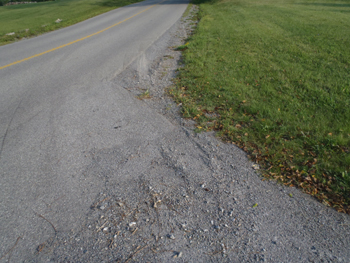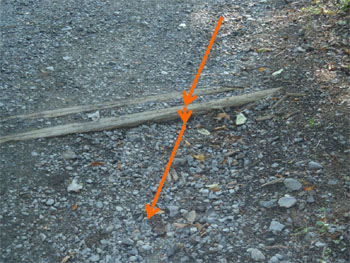Wash images one (1) through four (4) will be used to answer question eight.
|
Wash #1: A side bike path comes in from the left at the bottom of the picture to meet the main bike path. Cyclists cutting the corner short (notice the tracks in the mud just to the left of the arrow) are helping keep the grass from covering the dirt just there. You can see that there is a “plume” of dirt that has washed away from this bare place as shown by the arrow, and heads downhill away from us, angling across the bike trail towards Slab Cabin Run, which is just out of the picture on the far right. |
Wash #2: The pile of dirt is used for maintenance of the nearby baseball diamond at Spring Creek Park. Kids play on the pile, birds take dust baths on it when people aren’t around, and it is otherwise disturbed. When rain falls, the water runs towards the camera, around the parking bumper and out into the grass to the left. Notice the trail of dirt that the water has washed with it. |
|
Wash #3: Rainwater running toward the camera along the side of the road has washed gravel from the shoulder into the grass on the right, and on towards the camera across the driveway in the foreground. The Township pays people to add gravel occasionally, to prevent a major dropoff developing that could cause cars to wreck if a wheel dropped off the edge. |
Wash #4: In the Penn State agricultural lands north of the Penn Stater, boards have been placed across steeply sloping gravel roads to trap the loose rocks washed by rainwater. The hill slopes towards the camera. Rocks have piled up against the “dam” on the far side as high as the top of the board, clean water flows over and has eroded a little on the near side, creating the drop off we see, as shown by the arrows. These “dams” work, but they are far from perfect. |
Study these pictures, print them if you like, and then go answer question #8.



